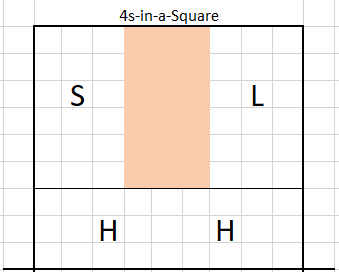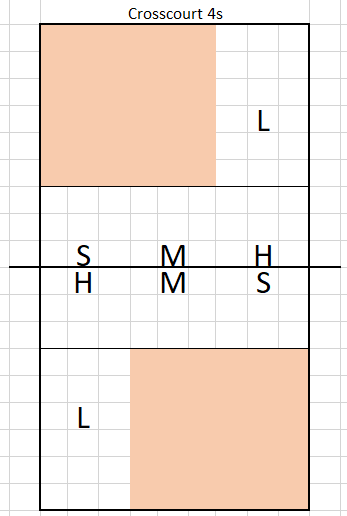November is Juniors Month at Smarter Volley. Juniors clubs have been underway in Europe for a little while now, and in North America most boys have already started and girls are just now getting going. Because of that, most of the content this month will be geared around the Juniors game and be directly applicable for Juniors coaches. But, a lot of it will be useful for coaches at other levels, including this one and the previous posts on Doubles and Triples variations. Enjoy!
(Reminder if you’re on the East Coast to consider registering for the Offensive Concepts seminar weekend Dec 17-18 in Wilmington, DE.)
What Are 4s Drills?
I define 4s drills as drills where you have a team of four people. And unlike the Doubles or Triples articles that I outlined, 4s almost always means we’re playing 4 v 4. I generally don’t incorporate Supporting Cast into 4s drills. Sometimes, due to practice numbers, a 4s team needs to have 3 or 5 players. I’ll explain that below.
Why 4s?
4s are the smallest unit of players that can have a true front court and back court. You can do it a little bit with the Partial-Court Triples variations we talked about last court, but 4s variations allow you to replicate just about all of the specific game geometries that your players need to master.
But on the other hand… another value of 4s drills is that you don’t have a full 6 players on the court. As we’ll see in some of the examples I show, this allows you to create Constraints to enhance teaching certain aspects of the game.
4s Examples
Unlike the Doubles and Triples posts, I’ll share some specific examples and you’ll be able to see the unifying themes.
4s-in-a-Square
This is a bread-and-butter one for me. You can run this with a front or back row setter, although I prefer a back row setter, because it allows for two front row attackers. Zone 6 is designated out-of-bounds. So now attackers have to hit to the perimeter of the court and you get a ton of reps working your crosscourt and line digging. I love running this Transition Wash style.
No Zone 5
Very similar concept to the in-a-square variation, only now we’re not hitting to Zone 5. Of course, if we’re not hitting to Zone 5, then we are hitting the ball to Zone 1, so you develop that as an attacker. It’s also nice to develop your pot throws to shallow Zone 6. If you play your libero in Zone 6, it’s also nice to get her some reps in that position.
It becomes a nice way to work out how your Zone 1 and Zone 6 defenders are going to handle attacks down the line: from the seam balls to true line shots to tips to pot throws.
Crosscourt 4s
This variation brings middle attacks and blockers into the picture. Hitters have to be pretty deliberate about where they attack the ball, which of course means that setters need to be precise as well.
Incorporating Into Practice
We can see now that these 4s drills have two big uses:
To isolate specific aspects of 6 v 6 offense and/or defense, by eliminating part of the court, constraining hitter options, and emphasizing specific offense/defense interactions.
To get really gamelike offense/defense interactions if you don’t have enough people to play 6 v 6.
Depending on what your practices look like, (2) might be even more valuable than (1). But let’s focus on (1) for a minute.
When you study volleyball, you see that certain situations occur with regularity. Most of you reading this are already aware of many of these situations and probably training some of them in certain situations. What these 4s drills do is create an opportunity where a few of those situations have to occur, because you’re eliminating certain options. In 4s-in-a-Square, you get a lot more setter digs, because they can only swing to 1 or 5 and, if you’re not confident of killing the ball in 5, you’d rather take on the setter. And because you’re going to get a lot more setter digs, you’re always going to get a lot of non-setter setting, just by the nature of the game.
So when I incorporate these drills into practice, my goal is think about some skills and/or situations in the game that I want the team to get better at and see if I can design a progression that goes Single-Skill and then into a 4s variation that will highlight that skill.
Doubles variations also lead into 4s well, because a Doubles team is obviously just half of a 4s team. So you can do some of the Single-Skill stuff that Doubles set ups allow for, leading into a competitive Doubles variation, which then leads into your 4s, which might be your main variation (if you don’t have 12 at practice) or would lead into your main 6 v 6 phase of practice.
Are you using any 4s variations like this that you like? Drop me a line in the comments.







Good stuff! I'm really looking forward to doing some no-zone-5 4s with my liberos and pins during small group training this spring.
We do a variation of 4s in a square where the person who took the first ball must set the second ball as well. Top 10 drill of all-time so far for me. Works on digging high, delivering 2nd ball (often somewhat on the run), OOS attacking, etc. - can do cooperative version but we often do competitive for quick games to 3 (for us, earned points only) and then switch around as needed. Hits that balance of useful constraints, competitive (and therefore fun), and easily repeatable + lots of reps in a quick amount of time in practice.